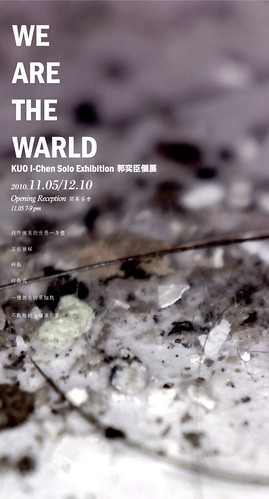
展覽期間 Exhibition:2010/11/05 - 12/10,13:00 - 18:00 週一休館 closed on Monday
活動地點 Venue:新苑藝術 / 台北市八德路三段12巷51弄17號
Galerie Grand Siècle / 17, Alley 51, Lane 12,
Ba-de Rd. Sec. 3, Taipei
開幕酒會 Opening Reception:2010/11/05 (Fri.),19:00-21:00
We are the world
We are the children...
世界,對我們來說,是什麼樣的存在?
一開始的認知總是自我的,就如同許多島嶼民族的語言中,該族名往往就是其語言中統稱「人」的意思。[1] 童年時期的郭奕臣,初聽到1985年傳唱全世界的慈善歌曲We Are the World,「世界」對他來說便是眼前所能見、身體所能及的一切--「我(們)就是世界」,直到年幼的他在偶然的機會下看見了地球儀,整片未知突然在面前開展…
We Are the WARLD
然而地球儀上的世界,在小男孩心中開展出的是單純地理上的邊界?還是用國家、種族、語言、膚色所劃下邊界,用以區分自我與他者?
一個人隨著成長和知識的累積,相對地認為對於世界可以掌握得愈多。但隨著全球化快速擴張,也帶來對於外在環境歸屬感的喪失與錯置,郭奕臣將此對世界的迷惘鎔鑄成一個新字:WARLD。如果說WORLD是世界,那麼WARLD則是一個變形的世界—是語言遊戲上的流動矛盾;是爭戰般的(war)衝突、騷動、拉扯;也是回歸到「我」(音近war)內視微觀的身體小宇宙...
對於世界,藝術家從向外的探索轉換為向內的尋找,身體成為他所唯一能真真切切掌握的疆土。郭奕臣說:「我是身體唯一能感知的東西,就像從身體上所剝落的碎屑與腳上殘留的灰塵泥土,都被操控背後的主體所掩蓋,彷彿一切是如此的美好像是對世界無盡的想像。」碎屑與灰塵成了細微的線索,抽絲剝繭「內」與「外」的衝突,提醒了一種回歸到身體、由身體出發的認知。
然而這種如孩童般直觀而天真的世界認知,我們可能都早已遺忘,但卻忠實而固執地深埋在語言當中:英文中WORLD這個字,追本溯源,乃是古英文woruld或worold而來,原意是「人類的存在」或「與生命相關的事物」--世界再寬再廣,終究是得回歸到最初,那個小男孩所能觸及的世界。
1 例如台灣原住民「達悟」、「泰雅」,在族語中原意均為「人」;紐西蘭原住民「毛利」在該族語言中也是「正常、普通人」的意思。
We are the world
We are the children...
What is the presence of the “world” like?
The first stage of cognition of the world is often self-centered, as we can find in the self-naming phenomenon among many island tribes.[1] At the age of 6, when young Kuo I-Chen first heard the charity song “We Are the World” in 1985, the term “world” was far from being great—for him, it was limited to all that he could see with his own eyes. The line “We Are the World” was arbitrarily summarized into a simple equation, “we = world.” Until one day, when he saw a terrestrial globe by chance, suddenly a mass of the unknown was unfolded before him…
We Are the WARLD
Were they purely geographical borders that the terrestrial globe unfolded before the little boy, or were they the borders drawn with the crayons of nations, ethnics, languages, and skin colors, so as to distinguish self and others?
As one grows up, the accumulation of knowledge seemingly brings the capability of knowing the world better. Nonetheless, with the explosive expansion of globalization, the sense of belonging is being nibbled away by the sense of loss and displacement. Kuo therefore coins a new word, warld, from his confusion about the world—a word game, as well as a metamorphosis. Semantically, it imagines war-like conflicts, turmoils, and collisions in our conception of the world. Phonologically, its first syllable is pronounced in a way similar to the Chinese character representing “me” (我)—a microcosmic universe that unfolds inwardly.
A quest into the world has been altered to a search into the self. The body has become the only tangible territory that the artist can grasp. As Kuo remarks, “My body is the only thing that I can perceive with certainty. While some unknown apparatus creates a wonderful picture of the world, the specks of dust from the shoes or exfoliated dead skin cells from the body remind me of another possible approach to perceive this world—a starting point that is purely bodily.”
This almost intuitive child-like perception of the world might have been long forgotten, but it is still deeply rooted in the language: etymologically, “world” evolved from Old English “woruld” or “worold” with an original meaning of “human existence; the affairs of life.” No matter how vast this world might be, the artist’s attempt is to return to the simple presence of the world that is tangible to the little boy.
沒有留言:
張貼留言